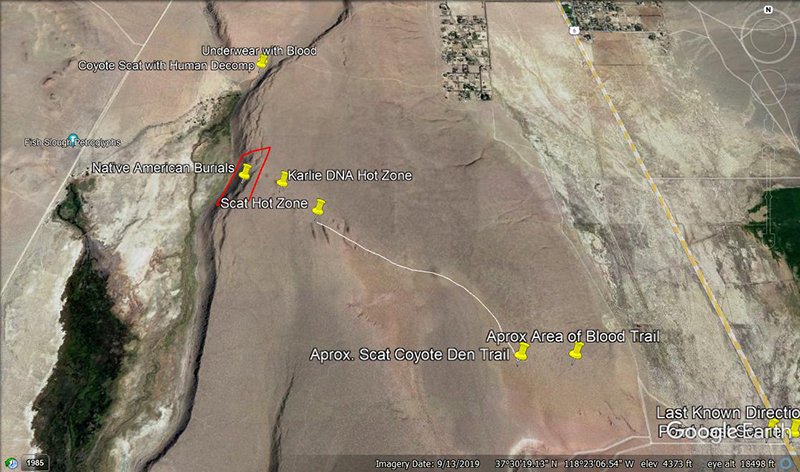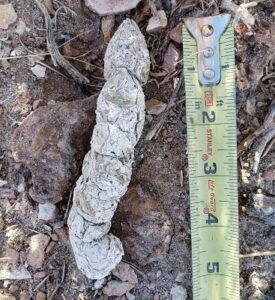
Forensic Magazine (on-line) recently published a terrific article on the Karlie Guse case. Retire police detective Paul Dostie, a co-founder of Forensic Recovery Services is prominently featured in the Forensic article.
Over the years, Det. Paul Dostie and forensic scientist Dr. Arpad A. Vass have devoted their lives to helping relatives and police to find missing loved ones presumed to be victims of foul play.
By republishing this well-written and researched article, we are helping Forensic Magazine to promulgate their article because it masterfully describes the Karlie Guse case, and also because Paul Dostie and Dr. Arpad Vass have occasionally been falsely maligned by people with nefarious agendas.
Det. Dostie and Dr. Vass are the real deal, and are among a handful of people in the world who know how to effectively find clandestine graves.
We encourage all our readers interested in forensics, to make Forensic Magazine a regular reading regimen. Over the years, there have been some amazing developments in forensic science and ForensicMag.com is leading the way in educating people on new forensic techniques which are making a life of crime more difficult everyday.
Some pictures in the article are from our library, and others are from Forensic Magazine. Below is the article in its entirety…
Adding Scat
to the
Missing Persons Identification Forensic Toolbox
DATELINE: February 16, 2022
By: Michelle Taylor, Editor-in-Chief
FORENSICMAG.COM
On Oct. 12, 2018, 16-year-old Karlie Gusé attended a party near her home in Chalfant Valley, a dessert town near Bishop, Calif. According to her boyfriend and others at the party, Karlie smoked marijuana—which may or may not have been laced with another drug—and immediately fell ill. She began to experience intense fear and paranoia, eventually calling her stepmother to ask for a ride home.
But, at 9 p.m., Melissa Gusé found Karlie running down a street, away from the party. No one knew it then, but that was only the first of two times Karlie would run scared down a street that night. No one saw her after the second time.
Melissa has recounted to investigators, including the FBI, that Karlie disappeared from her room sometime between 6:30 a.m. and 7:00 a.m. the next morning. This is corroborated by a neighbor on the other side of the highway—about .5 miles away—who thought it was odd to see a young girl out his way so early in the morning. He even noted that she only had on a T-shirt and sweatpants, despite it being 40˚ F the prior night.
After being called in as a private investigator, Paul Dostie, retired Mammoth Lakes Police Department sergeant, is positive he knows not only what happened to Karlie, but that the scat of coyotes dominant in the area prove his theory correct.
The Quantum Oscillator

Just as Dostie began training his black lab Buster as an avalanche rescue dog, he realized there was even more he could do—and it tied nicely into his previous work as a sergeant at the Mammoth Lakes Police Department.
From there, Dostie trained Buster, and later Bosco, to be Human Remains Detection dogs capable of sniffing out human decomposition, blood and DNA at the parts-per-trillion (ppt) level.
Dostie began working with History Flight, a non-profit that sends search and recovery teams around the world to investigate, locate and recover missing U.S. military personnel.
After an incredibly successful recovery rate, Dostie started to be called in as a third-party for unsolved/missing persons cases, including high-profile ones like the Kristin Smart case and the Tate murders linked to Charles Manson.
In these cases and others, Dostie often teams up with Arpad Vass, a biochemist by training who received his Ph.D. in forensic anthropology from the University of Tennessee and was a senior research scientist at Oak Ridge National Lab for 23 years.
Vass is the brains behind the patented “Quantum Oscillator.” As Vass describes it, the handheld instrument isolates and amplifies the natural vibrational frequency of virtually any object or material. This frequency is then directed outward into the environment using a directional antenna.
When it encounters an object with a similar frequency, it excites the molecules in that object in a manner similar to how a pulsed laser can excite objects. The “artificially excited” molecules then begin vibrating at a slightly higher state and at a slightly higher frequency. This frequency, emitted from the object, is then picked up by a receiving antenna in the Quantum Oscillator.
IMAGE DESCRIPTION
Since the frequency emitted and the frequency received are slightly different, an electromagnetic field between the two antennae helps compensate for this offset in frequencies. As the two frequencies attempt to align, the Quantum Oscillator sets up a standing wave oscillation, which indicates the positive detection of the object that is being hunted.
“Because this technology uses unique resonance frequencies, I am able to search for specific individuals—both live and deceased,” explained Vass in a statement to Forensic. “To accomplish this, I use familial keratin DNA for these types of searches.”

Scat search parties

About two months after Karlie’s disappearance, Vass and Dostie placed three of her baby teeth into the Quantum Oscillator.
Starting on the street where her house was, the instrument pushed them across the highway and past the neighbors house where Karlie was last seen.
Navigating through the bushes, rather than the dirt road, Vass and Dostie eventually found a blood trail a little more than half a mile from Karlie’s point last seen.
In fact, the Quantum Oscillator was signaling areas up to 3 miles away from the blood trail, and K9 Bosco was “alerting” Dostie often.
Still searching a week later, Dostie found a pair of underwear—with animal bites taken out of it—on a bush about 3 miles away from the blood trail.
“I brought the dog up and from 10 feet away, boom,” recalled Dostie to Forensic. “There’s so much decomp there in the soil beneath the bush. Immediately, we started looking for scat with the volunteer search party. First one I have the dog check, negative. Second one, from 3 feet away, Bosco alerts. And I go, ‘I know what happened to Karlie.’”
When the volunteers encountered scat with what they thought were human bones, Dostie called the Mono County Sheriff’s Office. They took samples and investigated but ultimately announced the evidence was not related to Karlie’s disappearance.
Dostie didn’t believe that. He had used scat previously to prove, in court, that a person was no long alive. So, the scat search parties continued. Volunteers bagged the coyote scat and GPS’ed it. Bosco alerted on 40% of all the scat collected from the 3-mile-wide search area.
“Studies by the FBI say it is 2-mile search area for animal disarticulation, and this is what we found as well,” said Dostie. “That’s a 4-mile circumference.”
Volunteers with drones also offered to join the search party. Two drones flew over the area low and slow, programmed to image every inch. All that data was sent to a photo-interpreter, who did identify a bone. However, it turned out to be a rabbit bone.
“But, the technology is obviously powerful,” said Dostie. “What they are doing is incredible. This is going to have repercussions, in a good way, when working on cases where there is animal disarticulation.”
Advanced analysis

Working with a spectroscopist he met during the Kristin Smart case, Dostie sent scat samples to be analyzed by gas chromatography mass spectrometer. According to Vass, the results indicated the presence of specific human decomposition chemical compounds.
Forging onward, Vass used his Quantum Oscillator and got a hit on some of the scat, finding four small bone chips in the feces. He employed laser induced breakdown spectroscopy (LIBS) to confirm the bones belonged to a human Caucasian.
Seeking even more detailed information, Dostie teamed up with Elena Zavala, an evolutionary geneticist who received her Ph.D. from Max-Planck-Institute for Evolutionary Anthropology.
Her newly published thesis focuses on employing methods from ancient DNA to improve the success rate of forensic identification.
Zavala attempted to get DNA out of the soil beneath where the underwear was located, but was unsuccessful. So, on Jan. 31, Dostie sent scat samples to Intermountain Forensics—the lab that is trying to extract DNA from bones of possible victims of the Tulsa Race Massacre—to see if human DNA is present.
If the results come back positive, Dostie said he will try to raise funds for DNA extraction again to possibly tie the samples to Karlie.
“Who else can it be?,” Dostie remarked.
Regardless of how Karlie’s case concludes, or doesn’t conclude, Dostie is proud of what his team has accomplished thus far and sees it as a turning point in missing persons investigations.
“When you put all this technology together—mass spectroscopy, LIBS, drones, and possibly getting DNA from the soil where the underwear was, that’s huge,” the retired sergeant said. “I think it’s really going to change search and rescue because you’re walking on top of evidence of where someone is. There different specialties blend really well together.”
